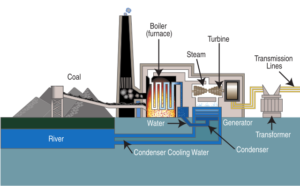The U.S. Environmental Protection Agency (EPA) on Jun. 2, 2014 issued a news release regarding a proposal to reduce the amount of carbon emitted from power plants.

In its news release, titled: “EPA Proposes First Guidelines to Cut Carbon Pollution from Existing Power Plants/Clean Power Plan is flexible proposal to ensure a healthier environment, spur innovation and strengthen the economy,” the federal regulatory agency expressed, “At the direction of President Obama and after an unprecedented outreach effort, the U.S. Environmental Protection Agency is today releasing the Clean Power Plan proposal, which for the first time cuts carbon pollution from existing power plants, the single largest source of carbon pollution in the United States. Today’s proposal will protect public health, move the United States toward a cleaner environment and fight climate change while supplying Americans with reliable and affordable power.”
According to the EPA in the Jun. 2nd release, approximately a third of all domestic greenhouse gas emissions are emitted from electric-generating facilities. The federal regulatory agency went on to stress that “there are currently no national limits on carbon levels.”
So, what in the proposal in question is going to “encourage” the electricity-generating concerns producing carbon and other harmful emissions, such as oxides of nitrogen and sulfur dioxide pollution, to step up to the plate, as it were, to make said operations cleaner?
The EPA notes, “The Clean Power Plan will be implemented through a state-federal partnership under which states identify a path forward using either current or new electricity production and pollution control policies to meet the goals of the proposed program. The proposal provides guidelines for states to develop plans to meet state-specific goals to reduce carbon pollution and gives them the flexibility to design a program that makes the most sense for their unique situation. States can choose the right mix of generation using diverse fuels, energy efficiency and demand-side management to meet the goals and their own needs. It allows them to work alone to develop individual plans or to work together with other states to develop multi-state plans.”
Being this is a proposal, question is: Will operators of the existing power plants (currently responsible for contributing the approximate one-third of U.S. atmospheric greenhouse gas emissions) just go along no questions asked and proceed to make any and all changes so as to make their operations cleaner or will there be some protest and resistance to this proposal?
At the same time, I have to scratch my head and wonder why the energy sector doesn’t itself take the lead and do all it can to make the generation of electricity more efficient, which, in turn, would result in the power-producing facilities producing carbon and other emissions being cleaner.
In making that happen, there no doubt would be costs attached and, those, presumably, would be passed on to consumers and these initially, I presume as well, would be higher. But, over time, I suspect that power-production costs would come down. And if this is the case, there is every reason to believe consumers could likewise benefit, such benefit being reflected in lower monthly electric bills.
The EPA itself brings to light that, “Since last summer, EPA has directly engaged with state, tribal, and local governments, industry and labor leaders, non-profits, and others. The data, information and feedback provided during this effort helped guide the development of the proposal and further confirmed the states have been leading the way for years in saving families and businesses money through improving efficiency, while cleaning up pollution from power plants. To date, 47 states have utilities that run demand-side energy efficiency programs, 38 have renewable portfolio standards or goals, and 10 have market-based greenhouse gas emissions programs. Together, the agency believes that these programs represent a proven, common-sense approach to cutting carbon pollution—one in which electricity is generated and used as efficiently as possible and which promotes a greater reliance on lower-carbon power sources.”
Honestly, I don’t know what there is not to like about this kind of proposal. It remains to be seen, however, if the plan put forth as presented gains traction and positive action taken results.
Image above: Tennessee Valley Authority
This post was last revised on May 19, 2020 @ 9:08 p.m. Pacific Daylight Time.
– Alan Kandel
